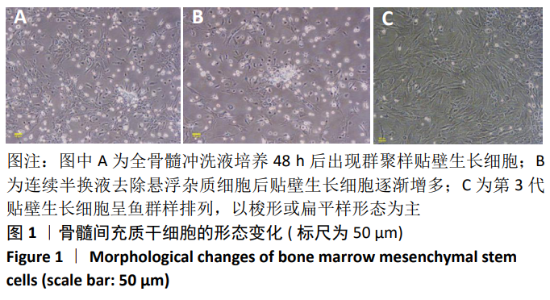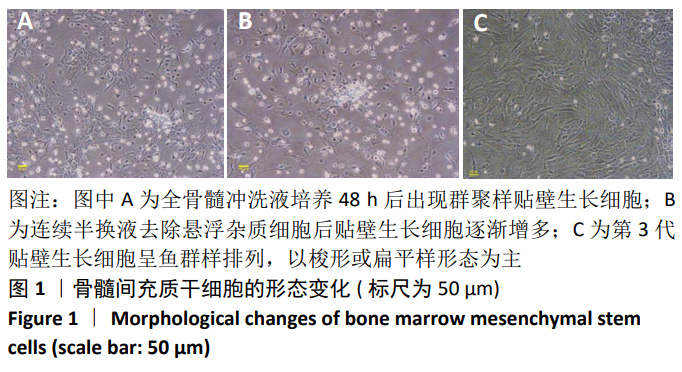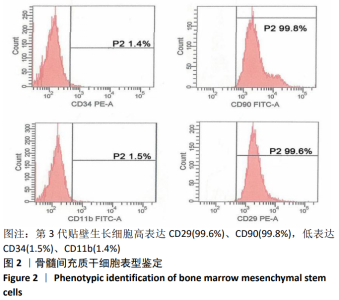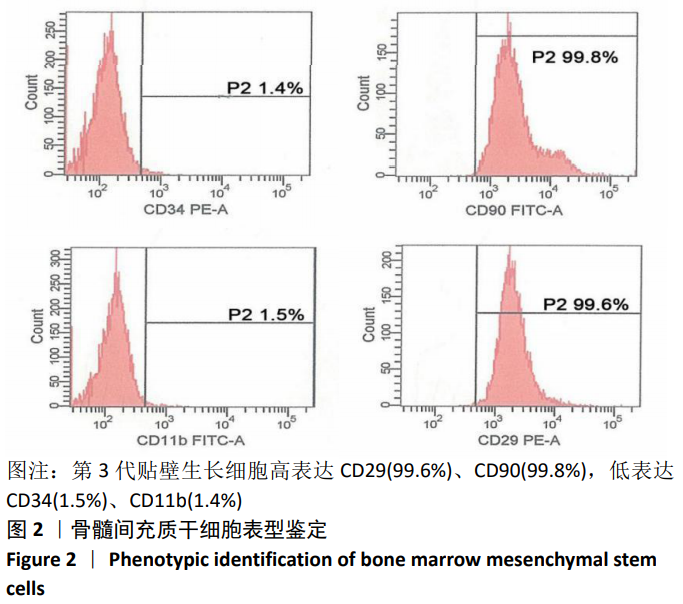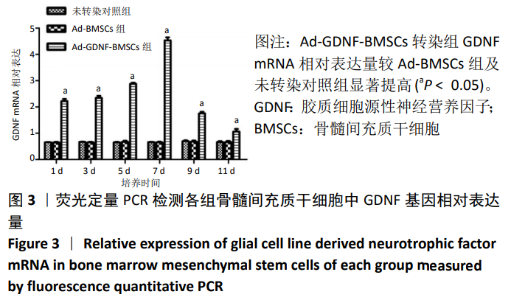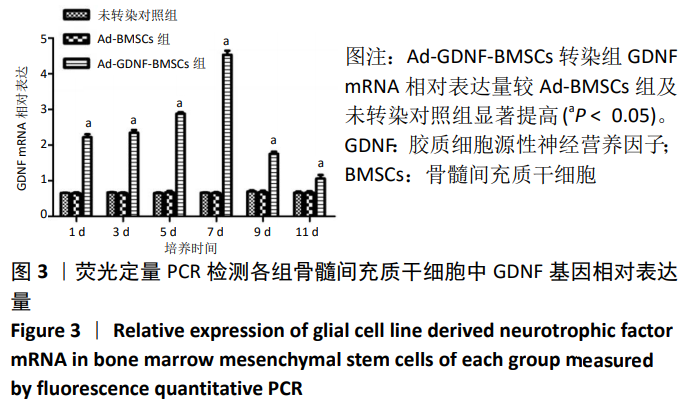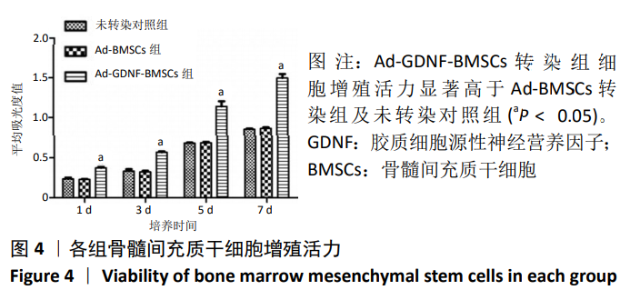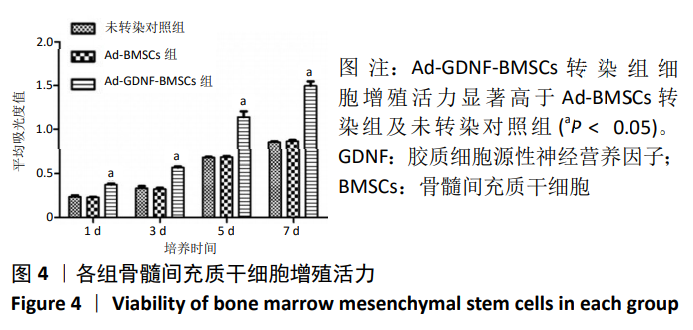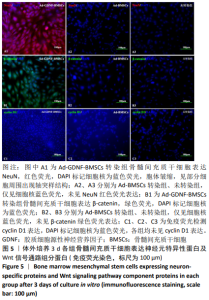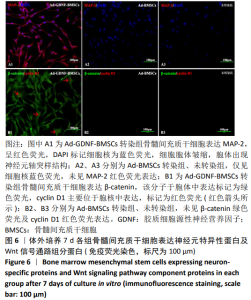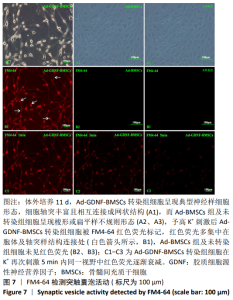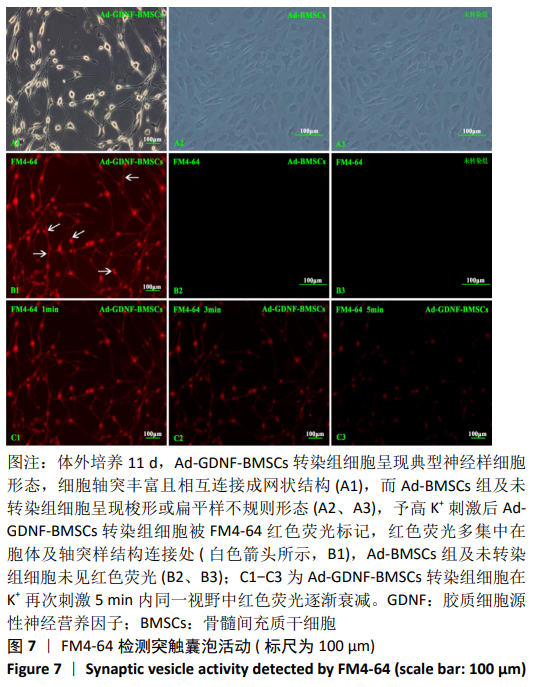Chinese Journal of Tissue Engineering Research ›› 2021, Vol. 25 ›› Issue (7): 1019-1025.doi: 10.3969/j.issn.2095-4344.2166
Previous Articles Next Articles
Mechanism of bone marrow mesenchymal stem cells differentiation into functional neurons induced by glial cell line derived neurotrophic factor
Zhu Xuefen1, Huang Cheng1, Ding Jian1, Dai Yongping1, Liu Yuanbing1, Le Lixiang1, Wang Liangliang1, Yang Jiandong2
- 1Rugao People’s Hospital, Rugao 226500, Jiangsu Province, China; 2Department of Spine Surgery, Northern Jiangsu People’s Hospital, Yangzhou 225000, Jiangsu Province, China
-
Received:2020-02-12Revised:2020-02-22Accepted:2020-04-03Online:2021-03-08Published:2020-12-08 -
Contact:Yang Jiandong, Chief physician, Associate professor, Master’s supervisor, Department of Spine Surgery, Northern Jiangsu People’s Hospital, Yangzhou 225000, Jiangsu Province, China -
About author:Zhu Xuefen, Rugao People’s Hospital, Rugao 226500, Jiangsu Province, China -
Supported by:the National Natural Science Foundation of China, No. 81071466; the Science and Education Leading Talents Program for Invigorating Health of Yangzhou during 13th Five-Year Plan Period, No. [2018]6; the Science and Technology Program of Nantong City, No. GJZ16044; the Science and Technology Program of Rugao City, No. SRG(15)3015
CLC Number:
Cite this article
Zhu Xuefen, Huang Cheng, Ding Jian, Dai Yongping, Liu Yuanbing, Le Lixiang, Wang Liangliang, Yang Jiandong. Mechanism of bone marrow mesenchymal stem cells differentiation into functional neurons induced by glial cell line derived neurotrophic factor[J]. Chinese Journal of Tissue Engineering Research, 2021, 25(7): 1019-1025.
share this article
| [1] SHAHREZAIE M, MANSOUR RN, NAZARI B, et al. Improved stem cell therapy of spinal cord injury using GDNF-overexpressed bone marrow stem cells in a rat model. Biologicals. 2017;50:73-80. [2] LU Y, GAO H, ZHANG M, et al. Glial Cell Line-Derived Neurotrophic Factor-Transfected Placenta-Derived Versus Bone Marrow-Derived Mesenchymal Cells for Treating Spinal Cord Injury. Med Sci Monit. 2018; 23:1800-1811. [3] YARAK S, OKAMOTO OK. Human adipose-derived stem cells: current challenges and clinical perspectives. An Bras Dermatol. 2010;85(5): 647-656. [4] KAKABADZE Z, KIPSHIDZE N, MARDALEISHVILI K, et al. Phase 1 Trial of Autologous Bone Marrow Stem Cell Transplantation in Patients with Spinal Cord Injury. Stem Cells Int. 2016;2016:6768274. [5] OH SK, CHOI KH, YOO JY, et al. A Phase III Clinical Trial Showing Limited Efficacy of Autologous Mesenchymal Stem Cell Therapy for Spinal Cord Injury. Neurosurgery. 2016;78(3):436-447. [6] 黄成,刘元兵,杨建东,等.过表达胶质细胞神经营养因子基因转染骨髓间充质干细胞移植治疗脊髓损伤[J].中国组织工程研究, 2020,24(7):1037-1045. [7] XIONG Y, ZHU JX, FANG ZY, et al. Coseeded Schwann Cells Myelinate Neurites From Differentiated Neural Stem Cells in neurotrophin-3-loaded PLGA Carriers. Int J Nanomedicine. 2012;7:1977-1989. [8] TAKEDA A, SHAKUSHI Y, TAMANO H. Modification of hippocampal excitability in brain slices pretreated with a low nanomolar concentration of Zn2+. J Neurosci Res. 2015;93(11):1641-1647. [9] FRIEDENSTEIN AJ, CHAILAKHJAN RK, LALYKINA KS. The development of fibroblast colonies in monolayer cultures of guinea-pig bone marrow and spleen cells. Cell Tissue Kinet. 1970;3(4):393-403. [10] FOUDAH D, MONFRINI M, DONZELLI E, et al. Expression of neural markers by undifferentiated mesenchymal-like stem cells from different sources. J Immunol Res. 2014;2014:987678. [11] LOPEZ-VERRILLI MA, CAVIEDES A, CABRERA A, et al. Mesenchymal stem cell-derived exosomes from different sources selectively promote neuritic outgrowth. Neuroscience. 2016;320:129-139. [12] PU YJ, MENG K, GU CL, et al. Thrombospondin-1 modified bone marrow mesenchymal stem cells (BMSCs) promote neurite outgrowth and functional recovery in rats with spinal cord injury. Oncotarget. 2017; 8(56):96276-96289. [13] ZENG X, QIU XC, MA YH, et al. Integration of donor mesenchymal stem cell-derived neuron-like cells into host neural network after rat spinal cord transection. Biomaterials. 2015;53:184-201. [14] SI HP, LU ZH, LIN YL, et al.Transfect bone marrow stromal cells with pcDNA3.1-VEGF to construct tissue engineered bone in defect repair. Chin Med J (Engl). 2012;125(5):906-910. [15] HU Y, ZHANG Y, TIAN K, et al. Effects of nerve growth factor and basic fibroblast growth factor dual gene modification on rat bone marrow mesenchymal stem cell differentiation into neuron-like cells in vitro. Mol Med Rep. 2016;13(1):49-58. [16] NOORI-ZADEH A, MESBAH-NAMIN SA, TIRAIHI T, et al. Non-viral human proGDNF gene delivery to rat bone marrow stromal cells under ex vivo conditions. J Neurol Sci. 2014;339(1-2):81-86. [17] DARABI S, TIRAIHI T, DELSHAD A, et al. In vitro non-viral murine pro-neurotrophin 3 gene transfer into rat bone marrow stromal cells. J Neurol Sci. 2017; 375:137-145. [18] GONG Y, WANG H, XIA H. Stable transfection into rat bone marrow mesenchymal stem cells by lentivirus-mediated NT-3. Mol Med Rep. 2015; 11(1):367-373. [19] LUO H, XU C, LIU Z, et al. Neural differentiation of bone marrow mesenchymal stem cells with human brain-derived neurotrophic factor gene-modified in functionalized self-assembling peptide hydrogel in vitro. J Cell Biochem. 2019; 120(3):2828-2835. [20] TIAN W, HAN XG, LIU YJ, et al. Intrathecal epigallocatechin gallate treatment improves functional recovery after spinal cord injury by upregulating the expression of BDNF and GDNF.Neurochem Res. 2013; 38(4):772-779. [21] SHEN Q, YIN Y, XIA QJ, et al. Bone Marrow stromal cells promote neuronal restoration in rats with traumatic brain injury: involvement of GDNF regulating BAD and BAX signaling. Cell Physiol Biochem. 2016; 38(2):748-762. [22] GU WD, ZHANG FJ, XUE QS, et al. Bone mesenchymal stromal cells stimulate neurite outgrowth of spinal neurons by secreting neurotrophic factors. Neurol Res. 2012;34(2):172-180. [23] JOSEPH M, DAS M, KANJI S, et al. Retention of stemness and vascul ogenic potential of human umbilical cord blood stem cells after repeated expansions on PES-nanofiber matrices. Biomaterials. 2014; 35(30):8566-8575. [24] CADIGAN KM, LIU YI. Wnt signaling: complexity at the surface. J Cell Sci. 2006;119(Pt 3):395-402. [25] LIU F, KOHLMEIER S, WANG CY. Wnt signaling and skeletal development. Cell Signal. 2008;20(6):999-1009. [26] VAN CAMP JK, BECKERS S, ZEGERS D, et al. Wnt signaling and the control of human stem cell fate. Stem Cell Rev. 2014;10(2):207-229. [27] FU HD, WANG HR, LI DH. BMP-7 accelerates the differentiation of rabbit mesenchymal stem cells into cartilage through the Wnt/β-catenin pathway. Exp Ther Med. 2017;14(6):5424-5428. [28] KATO T, KHANH VC, SATO K, et al. Elevated expression of Dkk-1 by glucocorticoid treatment impairs bone regenerative capacity of adipose tissue-derived mesenchymal stem cells. Stem Cells Dev. 2018;27(2): 85-99. [29] GUO C, LIU R, ZHAO HB, et al. Wnt/β-catenin signal pathway mediated Salidroside induced directional differentiation from mouse mesenchymal stem cells to nerve cells. Zhongguo Zhong Xi Yi Jie He Za Zhi. 2015;35(3):349-354. [30] FENG N, HAN Q, LI J, et al. Generation of highly purified neural stem cells from human adipose-derived mesenchymal stem cells by Sox1 activation. Stem Cells Dev. 2014;23(5):515-529. [31] 孙经淞,周雪颖,曲淑贤,等.骨髓间充质干细胞移植对脊髓损伤的修复作用[J].中国组织工程研究, 2018,22(1):59-64. [32] YUE W, YAN F, ZHANG YL, et al. Differentiation of rat bone marrow mesenchymal stem cells into neuron-like cells in vitro and co-cultured with biological scaffold as transplantation carrier. Med Sci Monit. 2016; 22:1766-1772. [33] LIN WW, LI M, LI Y, et al. Bone marrow stromal cells promote neurite outgrowth of spinal motor neurons by means of neurotrophic factors in vitro. Neurol Sci. 2014;35(3):449-457. [34] LI D, HÉRAULT K, OHEIM M, et al. FM dyes enter via a store-operated calcium channel and modify calcium signaling of cultured astrocytes. Proc Natl Acad Sci U S A. 2009;106(51):21960-21965. [35] NIEWEG K, ANDREYEVA A, VAN STEGEN B, et al. Alzheimer’s disease-related amyloid-β induces synaptotoxicity in human iPS cell-derived neurons. Cell Death Dis. 2015;6(4):e1709. [36] LIU C, HU Q, JING J, et al. Regulator of G protein signaling 5 (RGS5) inhibits sonic hedgehog function in mouse cortical neurons. Mol Cell Neurosci. 2017;83:65-73. [37] ANKOLEKAR SM, SIKDAR SK. Early postnatal exposure to lithium in vitro induces changes in AMPAR mEPSCs and vesicular recycling at hippocampal glutamatergic synapses. J Biosci. 2015;40(2):339-354. [38] DARABI S, TIRAIHI T, DELSHAD A, et al. Creatine enhances transdifferentiation of bone marrow stromal cell-derived neural stem cell into GABAergic neuron-Like cells characterized with differential gene expression. Mol Neurobiol. 2017;54(3):1978-1991. [39] DARVISHI M, TIRAIHI T, MESBAH-NAMIN SA, et al. Motor neuron transdifferentiation of neural stem cell from adipose-derived stem cell characterized by differential gene expression.Cell Mol Neurobiol. 2017;37(2):275-289. [40] LIU W, WANG YX, GONG FY, et al. Exosomes derived from bone mesenchymal stem cells repair traumatic spinal cord injury by suppressing the activation of A1 neurotoxic reactive astrocytes. J Neurotrauma. 2019;36(3):469-484. [41] CHEDLY J, SOARES S, MONTEMBAULT A, et al. Physical chitosan microhydrogels as scaffolds for spinal cord injury restoration and axon regeneration. Biomaterials. 2017;138:91-107. |
| [1] | Zhang Yu, Tian Shaoqi, Zeng Guobo, Hu Chuan. Risk factors for myocardial infarction following primary total joint arthroplasty [J]. Chinese Journal of Tissue Engineering Research, 2021, 25(9): 1340-1345. |
| [2] | Wang Haiying, Lü Bing, Li Hui, Wang Shunyi. Posterior lumbar interbody fusion for degenerative lumbar spondylolisthesis: prediction of functional prognosis of patients based on spinopelvic parameters [J]. Chinese Journal of Tissue Engineering Research, 2021, 25(9): 1393-1397. |
| [3] | Zhang Chao, Lü Xin. Heterotopic ossification after acetabular fracture fixation: risk factors, prevention and treatment progress [J]. Chinese Journal of Tissue Engineering Research, 2021, 25(9): 1434-1439. |
| [4] | Hou Jingying, Yu Menglei, Guo Tianzhu, Long Huibao, Wu Hao. Hypoxia preconditioning promotes bone marrow mesenchymal stem cells survival and vascularization through the activation of HIF-1α/MALAT1/VEGFA pathway [J]. Chinese Journal of Tissue Engineering Research, 2021, 25(7): 985-990. |
| [5] | Liang Xueqi, Guo Lijiao, Chen Hejie, Wu Jie, Sun Yaqi, Xing Zhikun, Zou Hailiang, Chen Xueling, Wu Xiangwei. Alveolar echinococcosis protoscolices inhibits the differentiation of bone marrow mesenchymal stem cells into fibroblasts [J]. Chinese Journal of Tissue Engineering Research, 2021, 25(7): 996-1001. |
| [6] | Geng Yao, Yin Zhiliang, Li Xingping, Xiao Dongqin, Hou Weiguang. Role of hsa-miRNA-223-3p in regulating osteogenic differentiation of human bone marrow mesenchymal stem cells [J]. Chinese Journal of Tissue Engineering Research, 2021, 25(7): 1008-1013. |
| [7] | Lun Zhigang, Jin Jing, Wang Tianyan, Li Aimin. Effect of peroxiredoxin 6 on proliferation and differentiation of bone marrow mesenchymal stem cells into neural lineage in vitro [J]. Chinese Journal of Tissue Engineering Research, 2021, 25(7): 1014-1018. |
| [8] | Pei Lili, Sun Guicai, Wang Di. Salvianolic acid B inhibits oxidative damage of bone marrow mesenchymal stem cells and promotes differentiation into cardiomyocytes [J]. Chinese Journal of Tissue Engineering Research, 2021, 25(7): 1032-1036. |
| [9] | Wang Feng, Zhou Liyu, Saijilafu, Qi Shibin, Ma Yanxia, Wei Shanwen. CaMKII-Smad1 promotes axonal regeneration of peripheral nerves [J]. Chinese Journal of Tissue Engineering Research, 2021, 25(7): 1064-1068. |
| [10] | Wang Zhengdong, Huang Na, Chen Jingxian, Zheng Zuobing, Hu Xinyu, Li Mei, Su Xiao, Su Xuesen, Yan Nan. Inhibitory effects of sodium butyrate on microglial activation and expression of inflammatory factors induced by fluorosis [J]. Chinese Journal of Tissue Engineering Research, 2021, 25(7): 1075-1080. |
| [11] | Wang Shiqi, Zhang Jinsheng. Effects of Chinese medicine on proliferation, differentiation and aging of bone marrow mesenchymal stem cells regulating ischemia-hypoxia microenvironment [J]. Chinese Journal of Tissue Engineering Research, 2021, 25(7): 1129-1134. |
| [12] | Chen Junyi, Wang Ning, Peng Chengfei, Zhu Lunjing, Duan Jiangtao, Wang Ye, Bei Chaoyong. Decalcified bone matrix and lentivirus-mediated silencing of P75 neurotrophin receptor transfected bone marrow mesenchymal stem cells to construct tissue-engineered bone [J]. Chinese Journal of Tissue Engineering Research, 2021, 25(4): 510-515. |
| [13] | Jiang Tao, Ma Lei, Li Zhiqiang, Shou Xi, Duan Mingjun, Wu Shuo, Ma Chuang, Wei Qin. Platelet-derived growth factor BB induces bone marrow mesenchymal stem cells to differentiate into vascular endothelial cells [J]. Chinese Journal of Tissue Engineering Research, 2021, 25(25): 3937-3942. |
| [14] | Sun Jianwei, Yang Xinming, Zhang Ying. Effect of montelukast combined with bone marrow mesenchymal stem cell transplantation on spinal cord injury in rat models [J]. Chinese Journal of Tissue Engineering Research, 2021, 25(25): 3962-3969. |
| [15] | Zhang Lishu, Liu Anqi, He Xiaoning, Jin Yan, Li Bei, Jin Fang. Alpl gene affects the therapeutic effect of bone marrow mesenchymal stem cells on ulcerative colitis [J]. Chinese Journal of Tissue Engineering Research, 2021, 25(25): 3970-3975. |
| Viewed | ||||||
|
Full text |
|
|||||
|
Abstract |
|
|||||
